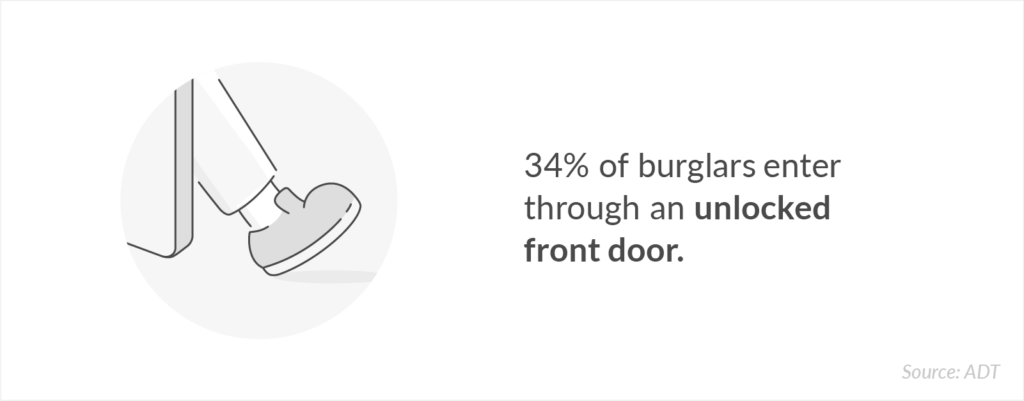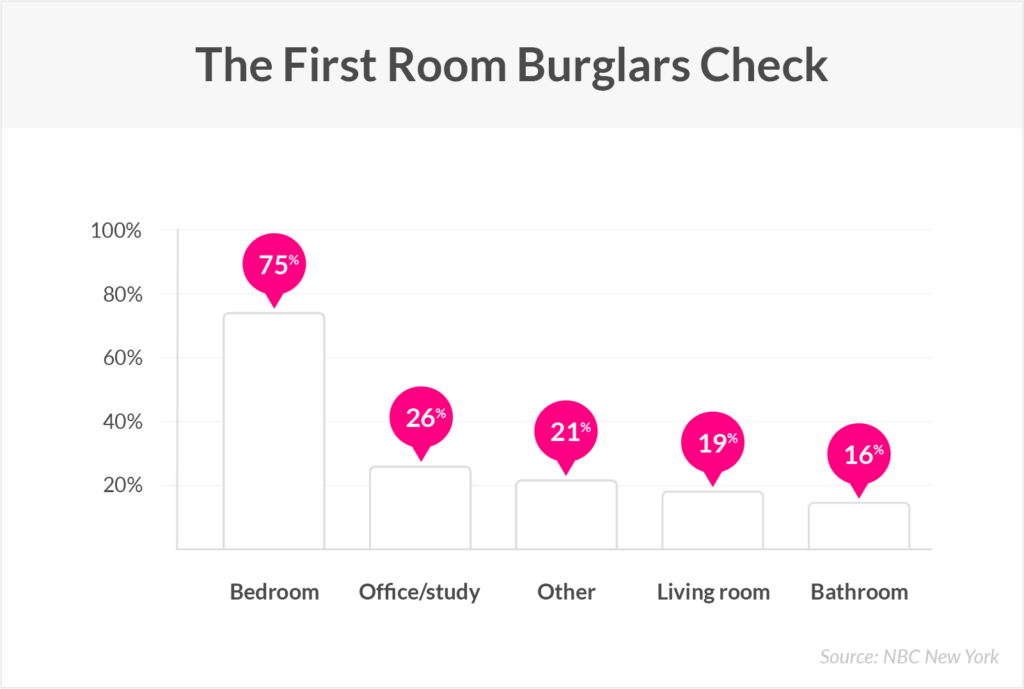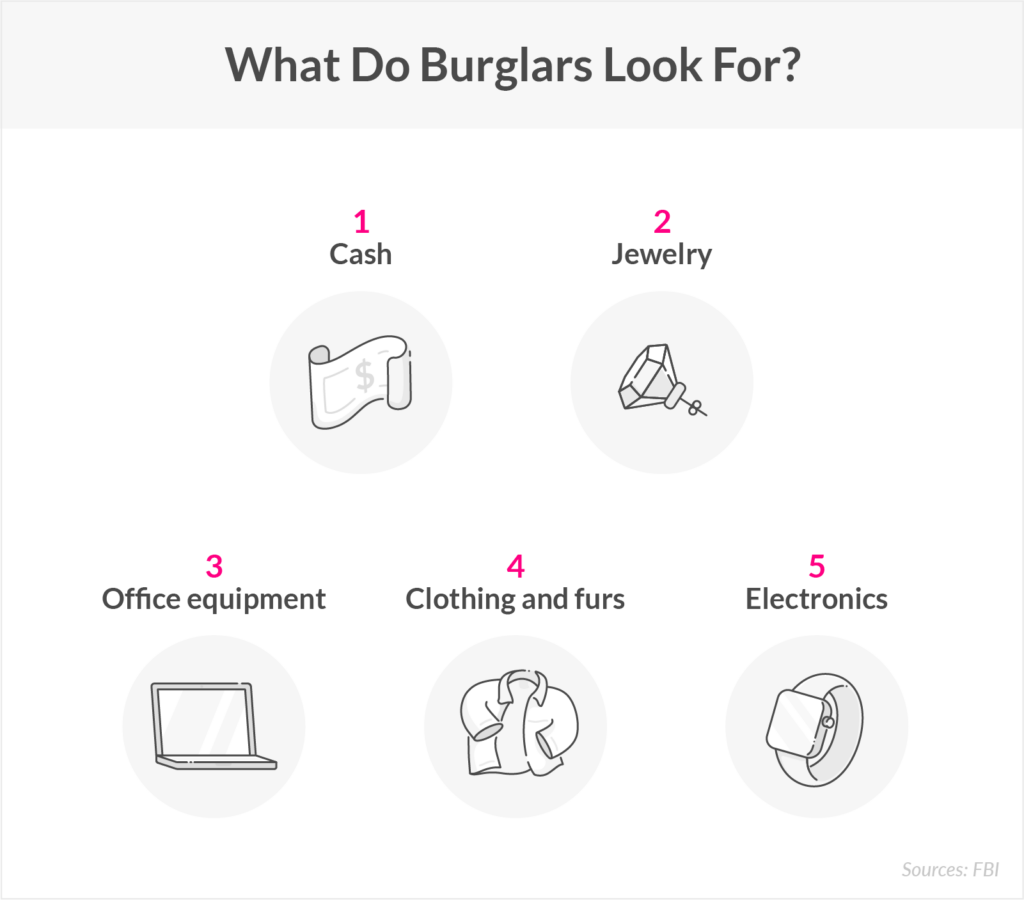39 Burglary Statistics to Help Protect Your Home
Understand the patterns and prevalence of burglaries to help safeguard your home and valuables.

Understand the patterns and prevalence of burglaries to help safeguard your home and valuables.

How safe do you feel in your home?
While many likely answer “safe” or “very safe,” the truth is that burglaries are an all-too-common occurrence in the United States.
While burglaries and trespassing declined 20% from 2019 to 2020¹, this was likely due to COVID-19 and people sheltering at home. As more of us return to the office and spend less time at home, new opportunities arise for burglars.
It’s not fun to think that strangers might be sizing up our homes and looking for weaknesses. However, knowing what burglars tend to look for when casing a home can make a world of difference to your safety.
After investing in your home via bank loans, savings, and homeowners insurance, you’ll also want the peace of mind knowing how to protect your stuff (and space) from looters.
To help understand the patterns and prevalence of burglars, we’ve compiled a list of statistics from the FBI and Bureau of Justice Statistics to show how burglaries happen—and offer tips to prevent them.
The FBI defines burglary as unlawful entry into a building with the intent to commit a crime (typically theft). Burglary falls under the category of property crime, which involves stolen or damaged property with or without the threat or use of force.
While these terms may seem similar, there are distinct differences between them.
With all the work you’ve put into furnishing, styling, sprucing up, and insuring your home, of course you want to know that you and your belongings are safe.
So what can recent statistics tell us about burglaries?
COVID-19 has skewed crime statistics a bit, as recent burglary and crime trends reflect the unique impact of the pandemic. (A burglar is likely less eager to try your front door if they think you’re working from home, or camped out binging Netflix.) In some cases, we relied on data that pre-dates the pandemic, with the hope of showing a more accurate depiction of key burglary trends in recent years.
Burglaries are the second most common type of property crime after larceny.

Burglaries can happen in a number of ways—from leaving a garage door open to having an unsecured doggy door. Here are a few of the most common forms of entry burglars use to get into a home.

A news station in New York surveyed¹⁰ convicted burglars serving sentences in New York and New Jersey to discover what areas of the home they were most likely to target. Here’s what the report uncovered.

While you might have expected the states with the highest burglary rates to be those with large metropolitan areas, you may be surprised to learn that New York and California do not top the list.
The table below breaks down the number of reported burglary cases by state.
| State | Total number of reported burglaries in 2020 | State | Total number of reported burglaries in 2020 |
|---|---|---|---|
| California | 145,529 | New Mexico | 13,665 |
| Texas | 108,851 | New Jersey | 12,983 |
| Florida | 52,293 | Wisconsin | 12,744 |
| North Carolina | 49,952 | Iowa | 11,739 |
| Washington | 40,167 | Nevada | 11,574 |
| Ohio | 37,279 | Virginia | 11,465 |
| New York | 32,003 | Massachusetts | 10,323 |
| Pennsylvania | 31,774 | Kansas | 9,655 |
| Georgia | 31,139 | Utah | 9,444 |
| Illinois | 31,020 | Connecticut | 6,656 |
| Tennessee | 26,479 | West Virginia | 4,877 |
| Arizona | 24,488 | Hawaii | 4,630 |
| Oklahoma | 24,415 | Nebraska | 4,455 |
| Louisiana | 23,698 | Idaho | 3,731 |
| South Carolina | 23,377 | North Dakota | 3,196 |
| Missouri | 23,300 | South Dakota | 3,036 |
| Colorado | 23,246 | Montana | 2,919 |
| Michigan | 23,231 | Alaska | 2,775 |
| Alabama | 19,660 | Delaware | 2,508 |
| Indiana | 18,938 | Maine | 2,009 |
| Minnesota | 17,370 | District of Columbia | 1,964 |
| Arkansas | 15,854 | Rhode Island | 1,763 |
| Kentucky | 15,407 | New Hampshire | 1,412 |
| Maryland | 15,261 | Wyoming | 1,225 |
| Mississippi | 14,488 | Vermont | 961 |
| Oregon | 14,386 |
Burglary rates in recent years have actually been on the decline and one reason for the downtick is the pandemic. Here’s what you should know about recent trends.
Burglary is one category of property crime, which also includes larceny-theft, motor vehicle theft, and arson. Here’s a closer look at recent property crime statistics in recent years.

There are always precautions you can take to help protect your home and your belongings from theft. Here are a few tips.
Posting about your vacation plans on social media is a great way to let burglars know that your home will be vacant. Consider waiting until after your amazing trip to post all your pics on Instagram, especially if your profile isn’t private.
Ask a trusted friend or family member to check on your home, pick up mail, and bring in packages while you’re away to make it look like someone’s home.
A proper home security system is obviously a great line of defense, though it might be too expensive for some budgets. That said, installing a home security system can help save you up to 20% on home insurance premiums.
Simpler home security features like a camera, or even a basic home-security yard sign, can often deter would-be burglars from attempting to break in.
Just like in The Sandlot, a “Beware of Dog” sign is often enough to scare off a potential trespasser. However, it helps to have… an actual dog. Large dogs were a deterrent for many convicted burglars surveyed in a Portland news station study⁶ on how burglaries happen.
Extra paranoid? A good habit to get into is leaving a battery-powered radio on when you leave the house. The sound of voices can be a simple deterrent to potential burglars.
According to ADT, 9% of home invaders gain access through the garage. Get in the habit of closing your garage door even when you’re home and install a deadbolt on doors leading into the home from your garage. Additionally, be sure to share garage door codes only with immediate family or trusted friends.
Storing your valuables in a safe rather than in a jewelry box or drawer can be an extremely effective way to keep them secure, even if a burglar strikes. Take care to purchase a large, heavy safe that is secured to a wall or floor rather than a portable one that a burglar could easily carry out with them.
When it comes to hiding your valuables, there are a few places you should steer clear of. John Lewis Finance and St Giles Trust¹⁹ interviewed convicted burglars to find out where they typically looked for valuables.
The obvious hiding places burglars target are:
Non-obvious hiding places that burglars avoid are:
Of course, you’ll want to make sure that when you cook rigatoni for dinner, you don’t end up boiling your heirloom jewelry on accident.
We’re happy to report that Lemonade home insurance does cover break-ins.
Homeowners insurance offers protection for your belongings and the structure of your home in the event of a burglary.
Your policy will kick in to reimburse you for stolen property. And if your home was damaged during the invasion—broken windows or damaged walls, for instance—the dwelling portion of your homeowners insurance will help take care of repairs.
There are some categories of personal property that are paid out at lower limits. For example, the standard homeowners insurance policy has a relatively low limit of liability for stolen jewelry, generally about $1,500.
If you own expensive jewelry and art, you should consider raising the limit of the liability or purchasing Extra Coverage to better protect your high-value items.
Items stolen outside of the home are also covered by homeowners insurance. So if your phone is stolen at a restaurant or your lawnmower is snatched from your shed, your homeowner’s insurance has your back.
If you’ve experienced a break-in, here are a few steps you’ll want to take as soon as possible.

While the idea of a burglary can be enough to keep you up at night, we hope these statistics offered a helpful peek into the minds of burglars, and inspired some ideas about how to safeguard your home and valuables.
One way to know that you’re in good hands in the event of a burglary is to choose a homeowners or renters insurance plan that properly covers you and your property. Whether you’re an avid art collector or a purse connoisseur, Lemonade can help you craft the perfect policy to help you sleep soundly at night.
Click below to get started!

¹Bureau of Justice Statistics
²Federal Bureau of Investigation
³Jacksonville State University
⁴ADT
⁵SafeAtLast
⁶KGW8
⁷Federal Bureau of Investigation Crime Data Explorer
⁸Alarms.org
⁹Frontpoint Security
¹⁰NBC New York
¹¹Statista – Burglary Rate by State
¹²Statista – Metropolitan Areas with the Highest Burglary Rate
¹³Statista – Burglary Rate in the US Since 1999
¹⁴Council on Criminal Justice
¹⁵EconoFact
¹⁶Statista – Percentage Distribution of Property Crime in the US by Type and Region
¹⁷Statista – Average Value of Property Stolen During Burglaries in the US
¹⁸Statista – Burglary Number by Location
¹⁹John Lewis Finance and St Giles Trust
²⁰SafeWise
Please note: Lemonade articles and other editorial content are meant for educational purposes only, and should not be relied upon instead of professional legal, insurance or financial advice. The content of these educational articles does not alter the terms, conditions, exclusions, or limitations of policies issued by Lemonade, which differ according to your state of residence. While we regularly review previously published content to ensure it is accurate and up-to-date, there may be instances in which legal conditions or policy details have changed since publication. Any hypothetical examples used in Lemonade editorial content are purely expositional. Hypothetical examples do not alter or bind Lemonade to any application of your insurance policy to the particular facts and circumstances of any actual claim.